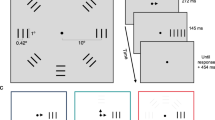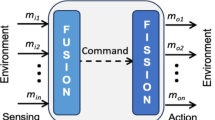Abstract
In this paper, we propose a method to increase vection strength through video image processing in the periphery, rather than the center, of the visual field. Specifically, we propose two methods. One is an image stretching process in the visual periphery and the other is an alpha-blending process with an expanding circle grating in the periphery of the field. We clarified the relationship between the processing conditions and vection strength and found that stretching in the left–right direction increased vection strength while stretching in the downward direction did not. When adding expanding grating by alpha-blending, vection strength and duration were increased in almost all cases.









Similar content being viewed by others
References
Sivak, M., et al.: The information that drivers use; is it indeed 90% visual? Perception 25(9), 1081–1089 (1996). https://doi.org/10.1068/p251081
Okano, Y., et al.: Investigation of stimulus presentation method in the visual periphery to enhance speed sensation (in Japan). IPSJ SIG Technical Reports 2008(11), 145–150 (2008)
Kawashima, Y., et al.: A method of changing motorists’ sense of speed by applying visually guided self-motion sensation generated by flashing columnar objects installed on the side of the road to traffic engineering (in Japan). ITE 65(6), 833–840 (2011). https://doi.org/10.3169/itej.65.833
Ito, T., et al.: Time-series effect of optical flow around the driver’s viewpoint image on speed perception (in Japan). Human Factors 24(2), 58–64 (2020). https://doi.org/10.11443/jphf.24.2_58
Suzuki, R., et al.: Guiding personal mobility with vection (in Japan). IPSJ Interaction 2017, 122–126 (2017)
Konishi, K., et al.: Analysis of linear vection effects produced by peripheral visual stimuli in an immersive video space (in Japan). IEICE 115(495), 223–228 (2016)
Genba, M., et al.: Research on human-vehicle systems using a large 5-plane stereoscopic driving simulator (in Japan). Transactions of Society of Automotive Engineers of Japan 47(3), 783–788 (2016)
Fujii, Y., Seno, T.: The effect of optical flow motion direction on vection strength. i-Perception 11(1), 1–13 (2020). https://doi.org/10.1177/2041669519899108
Seno, T., et al.: Wearing heavy iron clogs can inhibit vection. Multisensory Research 26(6), 569–580 (2013). https://doi.org/10.1163/22134808-00002433
Seno, T.: The oscillating potential model of visually induced vection. i-Perception 8(6) 1–24 (2017). https://doi.org/10.1177/2041669517742176
Seno, T.: Does immersion propensity correlate with vection strength? : A challenging study on immersion (in Japan). TVRSJ 21(1), 3–6 (2016)
Acknowledgements
This study was supported by JSPS Grants-in-Aid for Scientific Research JP19H04155, JP20H05702, JP20K21817, JP20K11919, JP22H00535, and JP23H03485, and by Hoso Bunka Foundation.
Author information
Authors and Affiliations
Corresponding author
Ethics declarations
Conflict of interest
The authors declare no conflicts of interest associated with this manuscript. The authors have no conflicts of interest directly relevant to the content of this article.
Additional information
Publisher's Note
Springer Nature remains neutral with regard to jurisdictional claims in published maps and institutional affiliations.
Rights and permissions
Springer Nature or its licensor (e.g. a society or other partner) holds exclusive rights to this article under a publishing agreement with the author(s) or other rightsholder(s); author self-archiving of the accepted manuscript version of this article is solely governed by the terms of such publishing agreement and applicable law.
About this article
Cite this article
Nakanishi, K., Mizushina, H. & Yamamoto, K. Increasing vection strength by video processing in the periphery of the visual field in a driving simulator. Opt Rev 31, 135–143 (2024). https://doi.org/10.1007/s10043-023-00854-4
Received:
Accepted:
Published:
Issue Date:
DOI: https://doi.org/10.1007/s10043-023-00854-4




